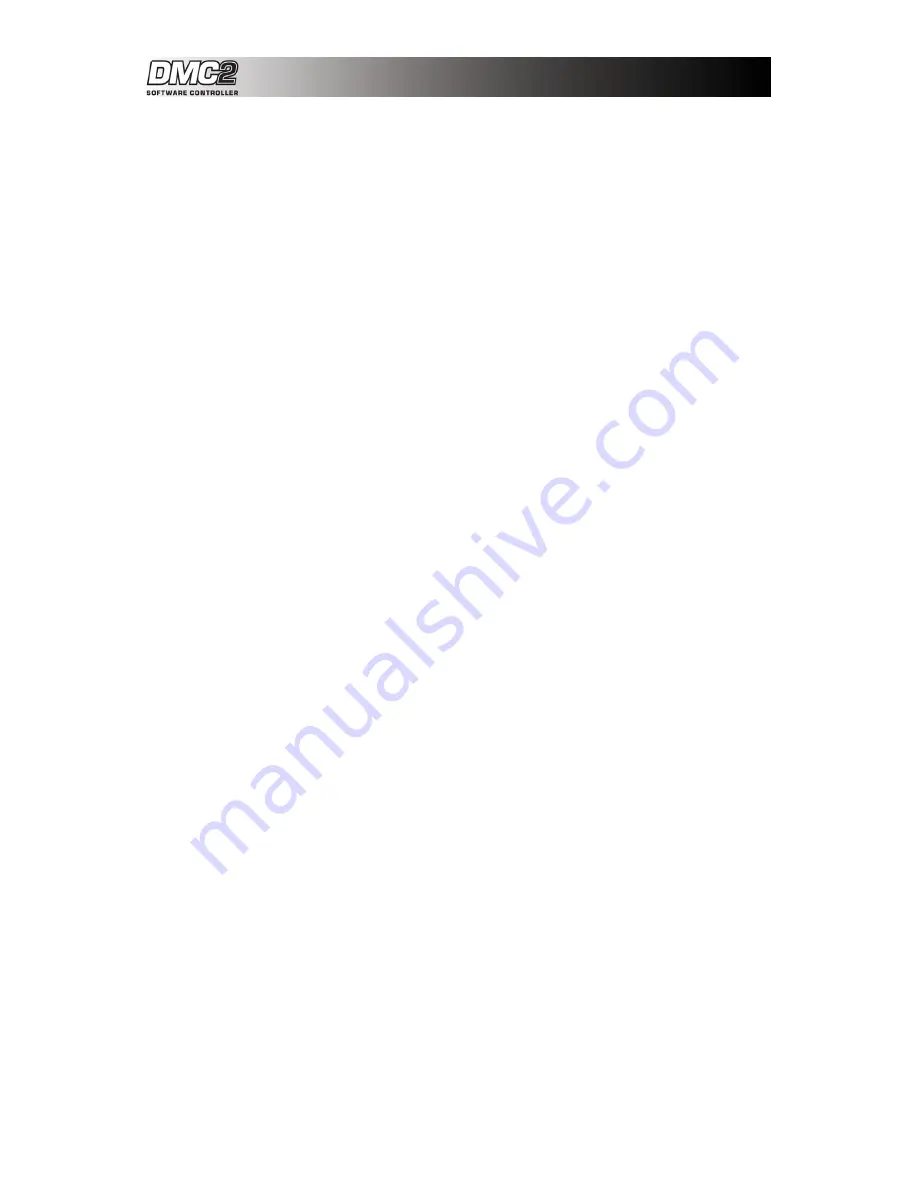
4
7.
MODE INDICATOR
– Shows the current function of
the track/load control knob.
8.
PLAY / STUTTER
– Pressing PLAY starts playback on
the corresponding deck. If you press PLAY while the
song is already playing, it will restart the music from the
last position you pressed PLAY from, creating a
“stutter” effect.
9.
PAUSE
– Pressing PAUSE once will pause the music
at the current location. Pressing PAUSE a second time
will return to the last set cue point (if one has been set).
Pressing a third time will return to the beginning of the
track.
10.
CUE
- Returns and pauses the music at the Cue Point.
To set a CUE Point, pause the song, seek to the
desired position, and then press CUE. Once you’re on
the Cue Point, pressing and holding down CUE allows
for temporary play of this point. The track will play for
as long as the button is held down and will return to the
Cue point once it has been released.
11.
JOG WHEEL
- Each virtual deck features a JOG
WHEEL, which can be used for scratching, pitch
bending and changing playback and cue position on
the corresponding deck. The functionality of the jog
wheel is determined by the WHEEL MODE button.
12.
WHEEL MODE
– This button determines the
functionality of the JOG WHEEL. The different
functions will be displayed on the screen and are as
follows:
•
In Nudge mode, the wheel can be used for
temporary adjustment of pitch, like a pitch bend.
•
In Scratch mode, the jog wheel can be used for
scratching the music on the deck, much like a
conventional DJ scratches a record.
•
In Move Loop mode, you can use the jog wheel to
move a loop forwards or backwards in time, if a
loop has already been set and engaged.
•
In Shrink Loop mode, you can use the jog wheel to
resize the loop length, if a loop has already been
set and engaged.
•
In Search mode (the display will show Pos=x%),
rotating the jog wheels will quickly scan through the
music loaded on the deck.
13.
PITCH
- Each virtual deck features a PITCH SLIDER,
which can be used to change the pitch or tempo of the
music playing on the corresponding deck.
14.
+ / -
PITCH BEND
– These two buttons are used for
temporary pitch bending and tempo adjustment for
beat alignment. The pitch or tempo will be affected for
as long as the button is held down and will return to
normal once the button has been released.
15.
PITCH ADJUST
– hold this button while moving the
pitch fader to change the relative position of the
pitch fader. For example, if you are using a pitch
range of +/- 8% (specified in the software) and then
select a pitch range of +/- 34% in the software,
moving the pitch slider will still give you only a +/- 8
pitch range. Youcan calibrate the pitch slider to
give you the full +/1 34% by using the PITCH
ADJUST feature. Hold the PITCH ADJUST button,
move the slider to the highest position, then move
the slider to the lowest position. When you release
the PITCH ADJUST button, the slider will give you
the full +/- 34 % range.
16.
KEYLOCK
– The KEYLOCK button engages the
Key Lock feature in CUE. When Key Lock is
engaged, the pitch of the music playing on the deck
will be locked to the current value. You can then
adjust the tempo of the music, independent of the
pitch.
17.
HOT STARTS
– Pressing these buttons will
instantly start playback from CUE points if
previously set. If no point is set, the first press will
assign the point, while the second press instantly
start playback from that point.
18.
SYNC
- When you press SYNC, CUE will sync the
tempo of the deck to the opposite deck’s tempo. If
you press SYNC while the song is paused, only the
pitch will be adjusted. If you press SYNC while the
song is playing, the beats will be smoothly aligned
too.
19.
LOOP IN / OUT
- A loop is any area of a track that
you choose to repeat seamlessly. Press LOOP IN
at the point where you wish the loop to start. Press
LOOP OUT when you reach the desired point to
mark the end point of the loop and the audio
between the two points will begin to loop
continuously. To release the loop and continue play
of the track press LOOP OUT again and the audio
will continue from the end point of the loop. If you
wish to set a new loop, just press LOOP IN again
while the loop is disengaged, and then press LOOP
OUT to begin the new loop.
20.
SMART LOOP
– When SMART LOOP is engaged,
all loops will be perfectly aligned with the beat of
the music playing.
21.
LOOP 1/8 - 8
- Pressing any of these buttons will
allow you to instantly create loops of the
corresponding size (in fractions of 1 bar). If a loop
is already active, then pressing any button will
change the loop size. To release the loop press
loop out.
22.
BACK BEAT
– Instantly allows the user to double
beats.
23.
VIDEO –
These buttons control CUE’s internal
video mixer, when working with video content.
24.
AUDIO
– These buttons activate the internal
software faders to create transitions without an
Audio mixer
25.
AUTOMIX –
Actives the automatic mixing function
of CUE.








